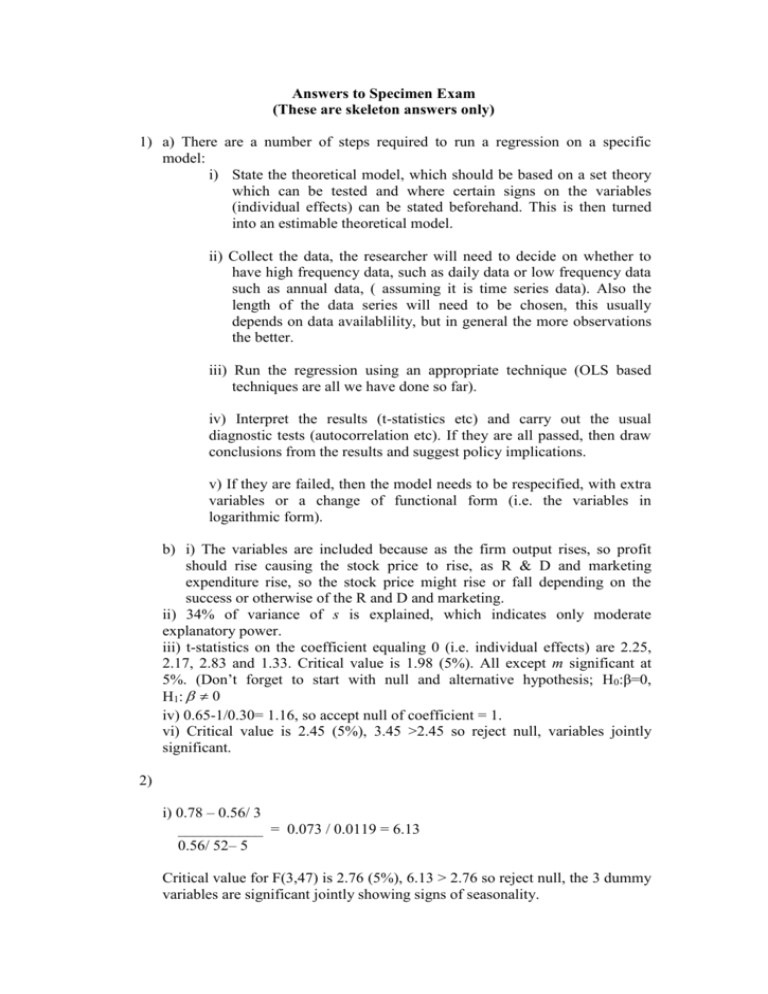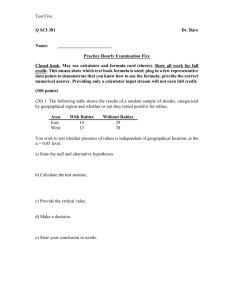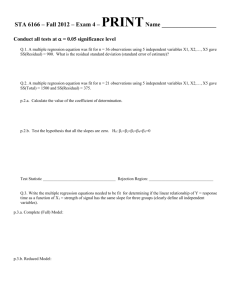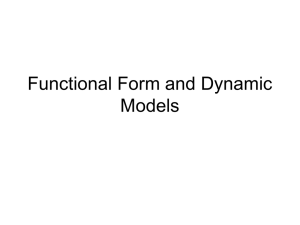Answers to Specimen Exam
advertisement

Answers to Specimen Exam (These are skeleton answers only) 1) a) There are a number of steps required to run a regression on a specific model: i) State the theoretical model, which should be based on a set theory which can be tested and where certain signs on the variables (individual effects) can be stated beforehand. This is then turned into an estimable theoretical model. ii) Collect the data, the researcher will need to decide on whether to have high frequency data, such as daily data or low frequency data such as annual data, ( assuming it is time series data). Also the length of the data series will need to be chosen, this usually depends on data availablility, but in general the more observations the better. iii) Run the regression using an appropriate technique (OLS based techniques are all we have done so far). iv) Interpret the results (t-statistics etc) and carry out the usual diagnostic tests (autocorrelation etc). If they are all passed, then draw conclusions from the results and suggest policy implications. v) If they are failed, then the model needs to be respecified, with extra variables or a change of functional form (i.e. the variables in logarithmic form). b) i) The variables are included because as the firm output rises, so profit should rise causing the stock price to rise, as R & D and marketing expenditure rise, so the stock price might rise or fall depending on the success or otherwise of the R and D and marketing. ii) 34% of variance of s is explained, which indicates only moderate explanatory power. iii) t-statistics on the coefficient equaling 0 (i.e. individual effects) are 2.25, 2.17, 2.83 and 1.33. Critical value is 1.98 (5%). All except m significant at 5%. (Don’t forget to start with null and alternative hypothesis; H0:β=0, H1: 0 iv) 0.65-1/0.30= 1.16, so accept null of coefficient = 1. vi) Critical value is 2.45 (5%), 3.45 >2.45 so reject null, variables jointly significant. 2) i) 0.78 – 0.56/ 3 ___________ = 0.073 / 0.0119 = 6.13 0.56/ 52– 5 Critical value for F(3,47) is 2.76 (5%), 6.13 > 2.76 so reject null, the 3 dummy variables are significant jointly showing signs of seasonality. ii) 0.78 – 0.45/ 5 ___________ = 0.066 / 0.01 = 6.6 0.45/ 52– 7 Critical value for F(5,45) is 2.45 (5%), 6.6> 2.45 so reject null, the 5 lagged variables are significant jointly. iii) Constant returns to scale can be tested using an F-test of a restriction in the usual way: In the Cobb-Douglas production function, output is determined by capital and labour. In logarithmic form: log yt 0 1 log kt 2 log lt ut (1) If constant returns to scale applies, whereby if the inputs double, output also doubles, we can test the restriction that the sum of the coefficients on the capital and labour variables sum to 1. This can then be written in the following form (Refer to Handout on webpage) log( yt lt ) 0 1 log( kt lt ) (2) This in effect is a restricted version of (1), in which constant returns to scale has been applied. We can test this restriction in exactly the same way as when we tested whether a group of variables jointly equals 0. Just run the two models, collect the RSS and substitute into the F-test formula, the null hypothesis is that the coefficients sum to 1. 3) This answer needs to show that if the data is not normally distributed, then it suggests that there are outliers in the data sample. These outliers can have a substantial effect on the result, giving a misleading conclusion. In addition it can have implications for the t and f statistics in small samples. One way to overcome the problem is to use an impulse dummy variable, which takes the value of 0 except for the outlier observation which takes the value of 1. In effect this is restricting this observation to having a value of 0. In addition the t-statistic on this dummy variable can provide information on the importance of the cause of the outlier, but we do need to relate it to a specific event. b) The Bera-Jarque test for normality involves testing for the presence of skewness and excess kurtosis in the distribution: b12 (b2 3) 2 ] 6 24 b1 coefficien t of skewness W T[ b2 coefficien t of excess kurtosis T number of observatio ns It follows a chi-squared distribution with 2 degrees of freedom, where the null hypothesis is that the residuals are normally distributed. c) To test for functional form, the Ramsey RESET test is used. To carry out the test involves running the model and saving both the residual and the fitted values. In the secondary regression the residual is regressed against powers of the fitted values. The test statistic is the TR2 statistic, with degrees of freedom equal to the highest power of the fitted value minus 1. So if up to the squared terms are included, there is one degree of freedom. The null hypothesis is that the functional form is appropriate. 4) This is a log linear model, where demand is based on price as well as a measure of supply which could represent marketing expenditure for their services. b) DW=1.57, dL = 1.55, dU = 1.67, so we can not be sure if we have 1st order autocorrelation or not. It could be due to an omitted variable. c) White statistic is 27.2. chi-squared (5) = 11.071. 27.2>11.07 so we reject null and conclude that we have heteroskedasticity, in which case the estimator is not BLUE. d) Given that the error variance follows the form: E (u t ) 2 2 xt2 , To ensure the error is not heteroskedastistic, we need to divide through by xt to give: y t xt u t xt xt xt xt 2 u E (u t ) 2 2 xt2 E t 2 2 2 xt xt xt This is no longer heteroskedastistic, as the variance of the new error term is now constant, so we can now estimate the above relationship. 5) The LPM is a discrete choice type approach, where the dependent variable takes the value of 1 or 0. The dependent variable follows a Bernoulli probability distribution, where the probability of getting a 1 is pi and the probability of getting a 0 is (1-pi). This gives the following linear probability model, where the regression line is fitted between the 0 and 1 observations. y Regression line (linear) 1 0 x As is evident from the above diagram, the regression line is not a good fit, so the R 2 statistic will be low. Further problems involve the nonfulfillment of the need for the estimated values of yi to lie between 0 and 1. Finally the probability is unlikely to be linear, which is assumed to be the case in this model. e.g. the decision to grant a mortgage or not (1,0) by a bank depending on an applicants income. This is unlikely to be linear as the change in probability between 20000 and 30000 dollars is likely to be much greater than between 500000 and 510000 dollars. b) An increase of 1% in the amount of debt leads to a 0.2% fall in the probability of default. A 1% increase in the financial structure (amount of long-tern debt) gives a 0.8% increase in the probability of default and a 1% increase in the firm’s output produces a 0.3% increase in the probability of default. Assuming all other things being the same. c) The critical value is 2.00 (5%), t-statistics are 4, 4 and 0.5, so all except output are significant. d) The R2 statistic is so low because of the poor fit of these types of model, as is evident in the earlier diagram. c) The probit model is based on a cumulative distribution function: p 1 CDF 0 x This accounts for the non-linear relationship of the observations, in this case unlike the Logit distribution it follows the normal distribution. This feature overcomes many of the problems with the LPM, in that it is not possible to get values above 1 or below 0 and it accounts for the non-linear relationship inherent in this type of modeling technique. The probit model can also be motivated by utility theory (Macfadden). i.e. Y=1 if we own a house and Y=0 if we do not own a house. We express an index I as: I t xt (x is income). We assume there is a critical value for this index I*, where if I exceeds I* the customer will own a house otherwise not. 6) Lags are used in financial econometrics to explain the dynamics of a model. The main reason is inertia of the dependent variable, where we do not get immediate adjustment following a shock to the model. The other reason is over-reaction, such as overshooting of the exchange rate. However there are many problems with this such as the way in which the most appropriate lag length is selected, the need for theoretical reasons for the lag structure and the potential problem of multicollinearity between the lags. b) This is the Koyck distribution, suggesting that y is dependent on weighted values of lags of x. Where the coefficients or weights of the lags on the explanatory variable decline geometrically. (λ lies between -1 and +1) Problems include multicollinearity and the possibility of multiple values for the parameters from the regression results. c) To carry out the Koyck transformation, which involves multiplying through by λ and lagging one time period, before taking this away new equation away from the original equation. This produces d) In the long-run the lagged variable become long-run variables (i.e. y*) to give the following: y * (1 ) y * x * vt y * (1 ) (1 ) x * vt y* (1 ) x * et









